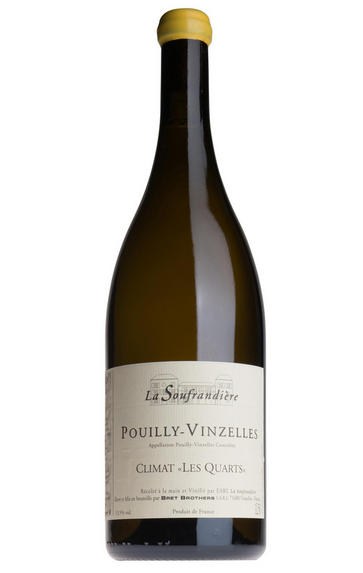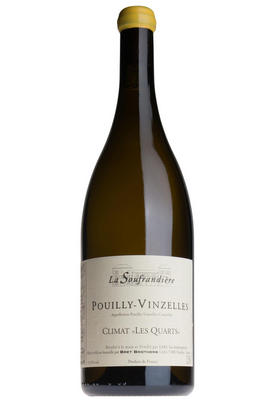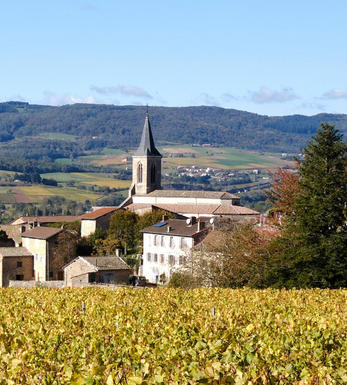
2020 Pouilly-Vinzelles, Climat Les Quarts, La Soufrandière, Bret Brothers, Burgundy

About this WINE

Bret Bros.
Grandfather Bret bought this property in Vinzelles in 1947. In 2000 Jean-Philippe and Jean-Guillaume Bret took their vineyards out of the local co-operative and established their Domaine de la Soufrandière (see here for the wine selection from la Soufrandière) with 4 hectares of vines entirely in the appellation of Pouilly Vinzelles. They have also developed a negociant activity using the name Bret Brothers.
Previous experience between them includes stages at Ridge and Newton in California and Comte Lafon in Burgundy. Most of their vines are in a perfectly situated east facing slope of Vinzelles called Les Quarts, on Bajocian limestone with a high silica/quartz content.
The vineyards have been farmed organically since 2000, with biodynamic principles being progressively introduced. The grapes, both their own and those purchased, are picked in small containers, then whole bunch pressed in the tinailler (local Maconnais and Beaujolais word for cuverie) before descending by gravity to the barrel cellar. They are currently all taken out of barrel for bottling after 11 months.

The Mâconnais
The Mâconnais is currently perhaps Burgundy’s most dynamic region. In the past, only Pouilly-Fuissé – a source of rich and ripe white wines – stood out from the crowd, but not only are such satellite appellations as Pouilly-Vinzelles and the newly-created (i.e., in 1998) Viré-Clessé coming alive, but a new generation of growers are also now producing some excellent Mâcon-Villages.
These wines used to be cheap and simple, rarely lasting more than a year or two after the vintage, but now one or two growers in each village are making proper, oak-aged, complex, and reasonably concentrated wines which will develop well in the bottle.
53 hectares of AC Mâcon (70% white).
406 hectares of AC Mâcon-Superieur (75% red).
1,840 hectares of AC Mâcon-Villages. Best individual villages include La Roche Vineuse, Lugny, Milly-Lamartine, Chardonnay, and Mâcon-Uchizy.
291 hectares of AC Saint-Véran. Recommended producers include Domaine des Deux Roches, and Olivier Merlin.
47 hectares of AC Pouilly-Vinzelles and 31 hectares of AC Pouilly-Loché. Recommended producers include Bret Bros and Domaine de la Soufrandiere.
211 hectares of AC Viré-Clessé. Recommended producers include Bret Bros, and Domaine Sainte Barbe.
764 hectares of AC Pouilly-Fuissé. Recommended producers include Ch de Fuisse, Ch des Rontets, Bret Bros, Olivier Merlin, and Cordier.

Chardonnay
Chardonnay is often seen as the king of white wine grapes and one of the most widely planted in the world It is suited to a wide variety of soils, though it excels in soils with a high limestone content as found in Champagne, Chablis, and the Côte D`Or.
Burgundy is Chardonnay's spiritual home and the best White Burgundies are dry, rich, honeyed wines with marvellous poise, elegance and balance. They are unquestionably the finest dry white wines in the world. Chardonnay plays a crucial role in the Champagne blend, providing structure and finesse, and is the sole grape in Blanc de Blancs.
It is quantitatively important in California and Australia, is widely planted in Chile and South Africa, and is the second most widely planted grape in New Zealand. In warm climates Chardonnay has a tendency to develop very high sugar levels during the final stages of ripening and this can occur at the expense of acidity. Late picking is a common problem and can result in blowsy and flabby wines that lack structure and definition.
Recently in the New World, we have seen a move towards more elegant, better- balanced and less oak-driven Chardonnays, and this is to be welcomed.


Buying options
Add to wishlist
Description
This is from the highest, stoniest part of this prized vineyard, a magical south-east facing slope. The vines are between 60 and 80 years old, their deep roots finding water in even the driest years. Ripe citrus and fresh chalk combine; it’s richly textured but with a nervy, mineral backbone. The is a wine for the long term. Drink 2025-2035.
wine at a glance
Delivery and quality guarantee